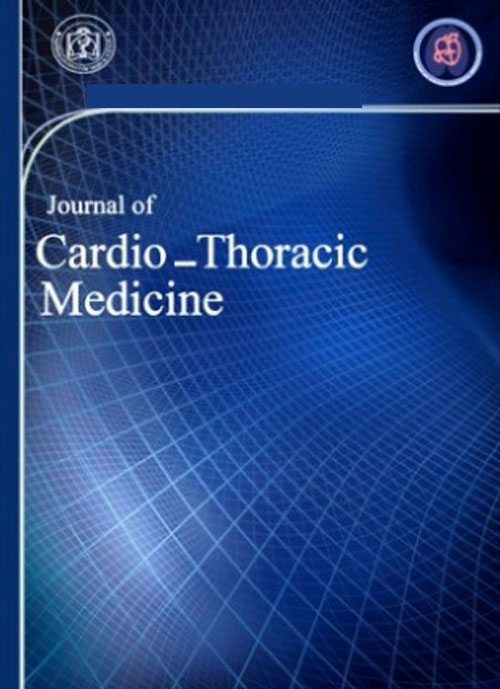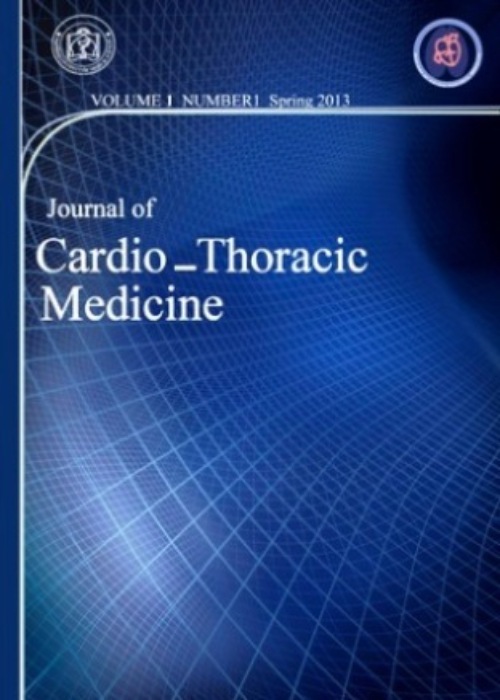فهرست مطالب

Journal of Cardio -Thoracic Medicine
Volume:2 Issue: 4, Autumn 2014
- تاریخ انتشار: 1393/08/12
- تعداد عناوین: 8
-
-
Pages 211-214IntroductionThere are significant gender differences in the epidemiology and presentation of cardiovascular diseases (CVDs), physiological aspects of CVDs, response to diagnostic tests or interventions, and prevalence or incidence of the associated risk factors. Considering the independent influence of gender on early dire consequences of such diseases, this study was conducted to investigate gender differences in patients'' beliefs about biological, environmental, behavioral, and psychological risk factors in a cardiac rehabilitation program.Materials And MethodsThis study has cross sectional design. The sample was composed of 775 patients referred to cardiac rehabilitation unit in Imam Ali Hospital in Kermanshah, Iran. The data were collected using clinical interview and patients’ medical records. The data were analyzed using descriptive statistics such as mean, standard deviation, and chi-square test. To do the statistical analysis, SPSS version 20 was utilized.ResultsAs the results indicated, there was a significant difference between the beliefs of men and women about risk factors of heart disease (X2= 48.36; P<0.01). Men considered behavioral (55.1%) and psychological (33.7%) risk factors as the main causes of their disease, respectively. On the other hand, women regarded psychological (38.2%) and behavioral factors (26.6%) as the most common causes of cardiac conditions, respectively. Both men and women considered stress as the most important heart disease risk factor (21% and 22.3%, respectively). Also, women were less aware of the risk factors, compared to men.ConclusionFrom the patients’ perspective, psychological and behavioral risk factors were the most important causes of cardiovascular diseases (CVDs); moreover, stress was the most influential risk factor for developing cardiac diseases. Thus, learning to control and manage these risk factors can help to prevent the development of CVDs and reduce the occurrence of subsequent cardiac events.Keywords: Blunt, Neck, Mortality, Penetrating, Trauma
-
Pages 215-220IntroductionThere are significant gender differences in the epidemiology and presentation of cardiovascular diseases (CVDs), physiological aspects of CVDs, response to diagnostic tests or interventions, and prevalence or incidence of the associated risk factors. Considering the independent influence of gender on early dire consequences of such diseases, this study was conducted to investigate gender differences in patients'' beliefs about biological, environmental, behavioral, and psychological risk factors in a cardiac rehabilitation program.Materials And MethodsThis study has cross sectional design. The sample was composed of 775 patients referred to cardiac rehabilitation unit in Imam Ali Hospital in Kermanshah, Iran. The data were collected using clinical interview and patients’ medical records. The data were analyzed using descriptive statistics such as mean, standard deviation, and chi-square test. To do the statistical analysis, SPSS version 20 was utilized.ResultsAs the results indicated, there was a significant difference between the beliefs of men and women about risk factors of heart disease (X2= 48.36; P<0.01). Men considered behavioral (55.1%) and psychological (33.7%) risk factors as the main causes of their disease, respectively. On the other hand, women regarded psychological (38.2%) and behavioral factors (26.6%) as the most common causes of cardiac conditions, respectively. Both men and women considered stress as the most important heart disease risk factor (21% and 22.3%, respectively). Also, women were less aware of the risk factors, compared to men.ConclusionFrom the patients’ perspective, psychological and behavioral risk factors were the most important causes of cardiovascular diseases (CVDs); moreover, stress was the most influential risk factor for developing cardiac diseases. Thus, learning to control and manage these risk factors can help to prevent the development of CVDs and reduce the occurrence of subsequent cardiac events.Keywords: Cardiac Rehabilitation, Gender Differences, Risk Factors, Patient's Beliefs
-
Pages 221-226IntroductionNo-reflow phenomenon in coronary vessels, manifested in some patients with reperfused acute myocardial infarction (MI), is associated with poor clinical and functional outcomes. Therefore, evaluation of predisposing risk factors can be helpful in risk assessment and identification of patients at higher risk. Herein, we aimed to study the predictive factors for the development of no-reflow phenomenon in patients with ST-elevation acute MI (STEMI), following primary percutaneous coronary intervention (PCI).Materials And MethodsOverall, 141 patients with STEMI, treated with primary PCI, were enrolled in a cross sectional study.. Angiographic data associated with no-reflow phenomenon including thrombolysis in MI (TIMI) were evaluated. Patients were divided into study and control (TIMI grade 3) groups. Demographic, clinical and laboratory (lab) data including cardiovascular risk factors (e.g., diabetes, hypertension, hyperlipidemia, smoking), door-to-balloon time, serum creatinine and glucose levels, white and red blood cell counts (WBC and RBC counts, respectively), mean platelet volume (MPV), and red cell distribution width (RDW) were evaluated in both groups.ResultsThe mean age of the patients was 60.3±11.9 years. No-reflow was observed in 35 (24.8%) cases. WBC count, MPV, serum creatinine, BS, and high-density lipoprotein (HDL) levels were significantly correlated with TIMI flowConclusionCertain lab indices including MPV, WBC count, creatinine and HDL levels played significant independent roles in the no-reflow phenomenon. Thus, measuring such parameters might be helpful in predicting the risk of this condition in patients; however, further studies are required.Keywords: Myocardial Infarction, No Reflow Phenomenon, Percutaneous Coronary Intervention
-
Pages 227-230IntroductionInsome cases, assist devices are required to ensure an adequate cardiac output after cardiac surgery. Intra-aortic balloon pump (IABP) is the most commonly used cardiac assist device, which provides first-line support for patients with heart failure. The aim of this study was to determine factors affecting the mortality rate of patients receiving IABP.Materials and MethodsIn this retrospective cohort study 235 patients requiring LABP support were analyzed over 14 years period (between January 1999 and December 2013) from which 137 patients survived the 30 days follow-up. Perioperative and demographic factors such as age, weight, underlying disease, ejection fraction, ventricular aneurysm and cardiopulmonary bypass and cross clamp time were recorded and analyzed.ResultsThe overall operative mortality was reported to be 41.7%. Male-to-female ratio was 131:104 and the mean age of the subjects was 57.58 ± 11.07 years. Early mortality rate was higher among young subjects and those with prolonged CBP (162.71±35.25, P<0.001) and ACC (129.94±54.39, P<0.001). In addition, mortality rate was higher among females (P=0.04). Patients’ weight, comorbidity, preoperative ejection fraction, ventricular aneurysm and stenosis of the left main coronary did not affect the mortality rate (P>0.05).ConclusionIABP is a simple, effective method for temporary cardiac support, especially for aged patients. In addition, lower duration of surgery is associated with better surgical outcomes.Keywords: Coronary Artery Surgery, Intra, aortic balloon pump, Survival Rate
-
Pages 231-237IntroductionSulfur mustard (SM), a toxic alkylating gas, can cause serious long-term pulmonary complications such as chronic obstructive pulmonary disease (COPD). Metabolic syndrome (MetS) is one of the important comorbidities of COPD. This study was designed to evaluate the frequency of metabolic syndrome in Iranian chemical warfare patients (CWPs) with COPD.Materials And MethodsThirty CWPs with a mean age of 46.93± 6.8 were enrolled in this study. The following parameters were studied in: complete pulmonary function tests, health-related quality of life, serum triglycerides (TG), high density lipoprotein (HDL) and fasting blood sugar (FBS) levels. Additionally, 32 COPD patients and 56 healthy persons were considered as control groups who were matched to CWPs.ResultsWe found a statistically significant difference in the frequency of MetS between the COPD patients and the healthy control group (p=0.04). Additionally, we observed a statistically significant difference in the mean HDL levels among these groups (p=<0.001). In the CWPs, the frequency of MetS was significantly decreased in severe to very severe stages (p<0.001).ConclusionOur data indicate that metabolic syndrome is frequent in chemical warfare patients, and special attention to this condition in mild to moderate stages is recommended.Keywords: Sulfur Mustard, Metabolic Syndrome, COPD, Chemical Warfare Patients
-
Pages 238-242IntroductionAbout one third of the world''s population is infected with tuberculosis (TB) and each year, about 1.5 to 2 million people die from TB. Procalcitonin (PCT) is an inflammatory marker that its level has variable results. There are some discussions in the utilization of PCT as a diagnostic marker in active pulmonary TB. The aim of this study was to compare serum PCT before and after treatment in patients with pulmonary TB.Materials And MethodsThis conducted on patients with pulmonary TB. Data were collected using a check list. The serum level of PCT was measured by ELISA test at the beginning and after six months of treatment. All data were analyzed using SPSS 16.ResultsForty-two patients with active pulmonary TB entered in this study. The mean age of the patients was 45.48 ± 12.54 years and 54.8% of them were male. Most of the patients (59.5 %) were rural inhabitants. There was a family history of TB in 26% of patients. The most common symptom (45.2%) was cough. Mean PCT prior to treatment was 1.25 ± 0.98 ng/ml. and 81% of the patients had PCT higher than 0.5 to 5. After treatment PCT level reduced significantly (P<0.001). The mean erythrocyte sedimentation rate (ESR) and C-reactive protein (CRP) before treatment were 45.88 ± 21.87 and 7.16 ± 3.98 respectively that were reduced significantly after treatment (P<0.001). Neutrophil counts before treatment was 6221 ± 3161 Cells per ml. and decreased statistically significant after treatment (P=0.01).ConclusionOur results showed that the PCT levels in pulmonary TB were high in active disease and reduced after treatment. PCT level may be used for follow-up as a discriminative marker between active and cured pulmonary TB and predict treatment response, although the PCT assay cannot be substituted for microbiological and pathological data.Keywords: Inflammatory Marker, Procalcitonin, Pulmonary Tuberculosis
-
Pages 243-245Chylothorax is an unusual cause of pleural effusion after the neonatal period in children without a previous history of cardiothoracic surgery. Determination of the causes of this condition can be often challenging. Herein, we present a case of a 6-month-old male infant, presenting with sudden severe breathlessness, which was later diagnosed as spontaneous left-sided chylothorax.Keywords: Chylothorax, Mesocardia, Respiratory Distress
-
Pages 246-248Congenital aortocaval fistula in association with complex congenital heart disease has never been described before. We represent an adult with tetralogy of fallot and an undiagnosed subclavian artery to superior vena cava fistula in previous catheterisms. He underwent surgical correction, successfully. After 8 months post operation he was doing well with improved functional capacity and no cyanosis.Keywords: Aortocaval, Congenital, Fistula


